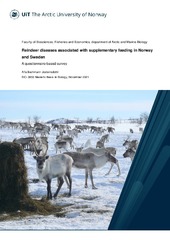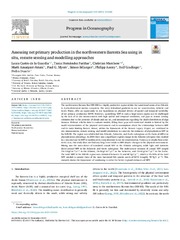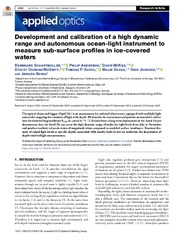Institutt for arktisk og marin biologi: Recent submissions
Now showing items 241-260 of 2086
-
Reindeer diseases associated with supplementary feeding in Norway and Sweden - A questionnaire-based survey
(Master thesis; Mastergradsoppgave, 2021-11-15)Climatic and anthropogenic factors are increasingly affecting reindeer husbandry in Norway and Sweden. The potential health risks associated with a warming climate, and the necessity to avoid starvation by providing supplementary feed to semi-domesticated reindeer, need to be explored and identified. A questionnaire-based survey among reindeer herders was conducted, containing questions about the ... -
Thermal properties of arctic fox fur and the effect of fur lice infestation.
(Master thesis; Mastergradsoppgave, 2023-11-15)In 2019, a new species of sucking louse was observed in arctic foxes (Vulpes lagopus) on Svalbard and Northern Canada. Abnormal patterns of fur loss, inconsistent with normal moult, were observed across the neck, shoulders and back, raising concerns as to how the animals would cope with damaged fur during the cold Arctic winter. This study investigates the impact of these lice on Svalbard arctic ... -
Assessing net primary production in the northwestern Barents Sea using in situ, remote sensing and modelling approaches
(Journal article; Tidsskriftartikkel; Peer reviewed, 2023-11-24)The northwestern Barents Sea (NW-BS) is a highly productive region within the transitional zones of an Atlantic to Arctic-dominated marine ecosystem. The steep latitudinal gradients in sea ice concentration, Atlantic and Arctic Water, offer an opportunity to test hypotheses on physical drivers of spatial and temporal variability of net primary production (NPP). However, quantifying NPP in such a ... -
Impact of autopolyploidy on leaf structure and photosynthesis in Saxifraga oppositifolia L.
(Master thesis; Mastergradsoppgave, 2023-12-01)Polyploidization can be a rapid path to speciation and is considered an important evolutionary mechanism. Some predict that all plants have undergone a polyploidization event during their evolutionary history, and the frequency of polyploid species increases with latitude. The Arctic-Alpine Saxifraga oppositifolia, an autopolyploid, has two polyploids that have successfully established themselves ... -
Seasonal Variations in Vertical Flux of particulate matter and composition in the Northern Barents Sea
(Master thesis; Mastergradsoppgave, 2023-11-15)The Barents Sea is an inflow shelf sea in the Arctic Ocean which experiences climate change consequently reduction in the sea ice extent thereby significantly impacting its ecological importance. This study investigates seasonal variations in the vertical flux of particulate matter including both particulate organic matter (chl a) and particulate inorganic matterin the form of CaCO3 contributed by ... -
The metabolic roles of astrocytes and neurons in the diving brain A study of the mitochondrial distribution in the brain of the hooded seal (Cystophora cristata)
(Master thesis; Mastergradsoppgave, 2023-11-15)The brain is highly dependent on oxygen for its metabolism and, in most mammals, major brain dysfunction occurs already within minutes of insufficient oxygen supply (hypoxia). Oxygen is the final electron acceptor in the electron transport system that drives the production of ATP through oxidative phosphorylation in the mitochondria. The rate at which oxidative phosphorylation produces ATP is dependent ... -
Nutritious and delicious? A non-invasive study of food plant choices by Svalbard reindeer in Summer and late Autumn
(Master thesis; Mastergradsoppgave, 2023-12-05)Seasonality affects growing patterns of vegetation and habitat use by herbivores. Short growing seasons make plants grow quickly through phenological stages which alters their nutrient levels and thus habitat use of herbivores that depend on energy assimilation in summer. Selective foraging that increases intake of high-quality forage can be highly advantageous and is usually a trade-off between ... -
Drivers of mercury accumulation over the ontogeny of perch (Perca fluviatilis) in the subarctic Pasvik watercourse
(Master thesis; Mastergradsoppgave, 2023-11-15)Understanding drivers of mercury (Hg) accumulation in freshwater food webs is vital due to its ability to accumulate in organisms and magnify in food webs to potent levels, potentially impacting wildlife and human health. This is of particular concern in regions where fish serve as an important food source. This study explores drivers of Hg accumulation in European perch (Perca fluviatilis) across ... -
Long-Term Effects on Somatic Growth, Life History Traits and Population Biology of Arctic Charr (Salvelinus alpinus) Following the Fish Culling Experiment in Takvatn
(Master thesis; Mastergradsoppgave, 2023-11-14)Stunting in fish populations is a special case of density-dependent growth characterized by old slow-growing individuals with low recreational and resource use value. The phenomenon is commonly observed in lacustrine populations of Arctic charr (Salvelinus alpinus) in temperate regions. In Takvatn, a subarctic lake in northern Norway, stunted growth of Arctic charr was attributed to food shortage ... -
Drivers of an unexpected unimodal vertical pattern in size distribution of intertidal blue mussels (Mytilus spp.)
(Master thesis; Mastergradsoppgave, 2023-11-14)Blue mussels (Mytilus spp.) are important ecosystem bioengineers and provide numerous of ecosystem services. They are found worldwide, but face a global population decline for unclear reasons in many regions. A pilot study in the subarctic rocky intertidal shore in Northern Norway revealed an unexpected unimodal pattern in the body size of blue mussels along a vertical transect from low to high ... -
Development and calibration of a high dynamic range and autonomous ocean-light instrument to measure sub-surface profiles in ice-covered waters
(Journal article; Tidsskriftartikkel; Peer reviewed, 2023-10-23)The optical chain and logger (OptiCAL) is an autonomous ice-tethered observatory equipped with multiple light sensors for mapping the variation of light with depth. We describe the instrument and present an ensemble calibration for downwelling irradiance E<sub>PAR</sub> in [µmolm<sup>−2</sup>s<sup>−1</sup>]. Results from a long-term deployment in the Arctic Ocean demonstrate that the OptiCAL can ... -
Biogeography of microbial communities in high-latitude ecosystems: Contrasting drivers for methanogens, methanotrophs and global prokaryotes
(Journal article; Tidsskriftartikkel; Peer reviewed, 2023-10-27)Methane-cycling is becoming more important in high-latitude ecosystems as global warming makes permafrost organic carbon increasingly available. We explored 387 samples from three high-latitudes regions (Siberia, Alaska and Patagonia) focusing on mineral/organic soils (wetlands, peatlands forest), lake/pond sediment and water. Physicochemical, climatic and geographic variables were integrated ... -
Cuscuta campestris fine-tunes gene expression during haustoriogenesis as an adaptation to different hosts
(Journal article; Tidsskriftartikkel; Peer reviewed, 2023-09-14)The Cuscuta genus comprises obligate parasitic plants that have an unusually wide host range. Whether Cuscuta uses different infection strategies for different hosts or whether the infection strategy is mechanistically and enzymatically conserved remains unknown. To address this, we investigated molecular events during the interaction between field dodder (Cuscuta campestris) and two host species ... -
Model-informed classification of broadband acoustic backscatter from zooplankton in an in situ mesocosm
(Journal article; Tidsskriftartikkel; Peer reviewed, 2023-12-07)Classification of zooplankton to species with broadband echosounder data could increase the taxonomic resolution of acoustic surveys and reduce the dependence on net and trawl samples for ‘ground truthing’. Supervised classification with broadband echosounder data is limited by the acquisition of validated data required to train machine learning algorithms (‘classifiers’). We tested the hypothesis ... -
Impacts of a warming climate on concentrations of organochlorines in a fasting high arctic marine bird: Direct vs. indirect effects?
(Journal article; Tidsskriftartikkel; Peer reviewed, 2023-10-30)The present study examined how climate changes may impact the concentrations of lipophilic organochlorines (OCs) in the blood of fasting High Arctic common eiders (Somateria mollissima) during incubation. Polychlorinated biphenyls (PCBs), 1-dichloro-2,2-bis (p-chlorophenyl) ethylene (p,p′-DDE), hexachlorobenzene (HCB) and four chlordane compounds (oxychlordane, trans-chlordane and trans- and ... -
The positive effect of plant diversity on soil carbon depends on climate
(Journal article; Tidsskriftartikkel; Peer reviewed, 2023-10-19)Little is currently known about how climate modulates the relationship between plant diversity and soil organic carbon and the mechanisms involved. Yet, this knowledge is of crucial importance in times of climate change and biodiversity loss. Here, we show that plant diversity is positively correlated with soil carbon content and soil carbon-to-nitrogen ratio across 84 grasslands on six continents ... -
Still Arctic? — The changing Barents Sea
(Journal article; Tidsskriftartikkel; Peer reviewed, 2023-11-13)The Barents Sea is one of the Polar regions where current climate and ecosystem change is most pronounced. Here we review the current state of knowledge of the physical, chemical and biological systems in the Barents Sea. Physical conditions in this area are characterized by large seasonal contrasts between partial sea-ice cover in winter and spring versus predominantly open water in summer and ... -
Diffusive and advective cross-frontal fluxes of inorganic nutrients and dissolved inorganic carbon in the Barents Sea in autumn
(Journal article; Tidsskriftartikkel; Peer reviewed, 2023-11-21)The Atlantic Water, entering the Arctic through the Barents Sea and Fram Strait, is the main source of nutrients in the Arctic Ocean. The Barents Sea is divided by the Polar Front into an Atlantic-dominated domain in the south, and an Arctic-dominated domain in the north. The Polar Front is a thermohaline structure, which is topographically-steered at sub-surface, and influenced by the seasonal ... -
Hydrography, inorganic nutrients and chlorophyll a linked to sea ice cover in the Atlantic Water inflow region north of Svalbard
(Journal article; Tidsskriftartikkel; Peer reviewed, 2023-11-04)Changes in the inflow of Atlantic Water (AW) and its properties to the Arctic Ocean bring more warm water, contribute to sea ice decline, promote borealisation of marine ecosystems, and affect biological and particularly primary productivity in the Eurasian Arctic Ocean. One of the two branches of AW inflow follows the shelf break north of Svalbard, where it dominates oceanographic conditions, ... -
Abrupt permafrost thaw triggers activity of copiotrophs and microbiome predators
(Journal article; Tidsskriftartikkel; Peer reviewed, 2023-10-05)Permafrost soils store a substantial part of the global soil carbon and nitrogen. However, global warming causes abrupt erosion and gradual thaw, which make these stocks vulnerable to microbial decomposition into greenhouse gases. Here, we investigated the microbial response to abrupt in situ permafrost thaw. We sequenced the total RNA of a 1 m deep soil core consisting of up to 26 500-year-old permafrost ...


 English
English norsk
norsk


















